Georg Martius
Max Planck Institute for Intelligent Systems
Hard Contacts with Soft Gradients: Refining Differentiable Simulators for Learning and Control
Jun 17, 2025Abstract:Contact forces pose a major challenge for gradient-based optimization of robot dynamics as they introduce jumps in the system's velocities. Penalty-based simulators, such as MuJoCo, simplify gradient computation by softening the contact forces. However, realistically simulating hard contacts requires very stiff contact settings, which leads to incorrect gradients when using automatic differentiation. On the other hand, using non-stiff settings strongly increases the sim-to-real gap. We analyze the contact computation of penalty-based simulators to identify the causes of gradient errors. Then, we propose DiffMJX, which combines adaptive integration with MuJoCo XLA, to notably improve gradient quality in the presence of hard contacts. Finally, we address a key limitation of contact gradients: they vanish when objects do not touch. To overcome this, we introduce Contacts From Distance (CFD), a mechanism that enables the simulator to generate informative contact gradients even before objects are in contact. To preserve physical realism, we apply CFD only in the backward pass using a straight-through trick, allowing us to compute useful gradients without modifying the forward simulation.
Learning 3D-Gaussian Simulators from RGB Videos
Mar 31, 2025Abstract:Learning physics simulations from video data requires maintaining spatial and temporal consistency, a challenge often addressed with strong inductive biases or ground-truth 3D information -- limiting scalability and generalization. We introduce 3DGSim, a 3D physics simulator that learns object dynamics end-to-end from multi-view RGB videos. It encodes images into a 3D Gaussian particle representation, propagates dynamics via a transformer, and renders frames using 3D Gaussian splatting. By jointly training inverse rendering with a dynamics transformer using a temporal encoding and merging layer, 3DGSimembeds physical properties into point-wise latent vectors without enforcing explicit connectivity constraints. This enables the model to capture diverse physical behaviors, from rigid to elastic and cloth-like interactions, along with realistic lighting effects that also generalize to unseen multi-body interactions and novel scene edits.
A Smooth Analytical Formulation of Collision Detection and Rigid Body Dynamics With Contact
Mar 14, 2025Abstract:Generating intelligent robot behavior in contact-rich settings is a research problem where zeroth-order methods currently prevail. A major contributor to the success of such methods is their robustness in the face of non-smooth and discontinuous optimization landscapes that are characteristic of contact interactions, yet zeroth-order methods remain computationally inefficient. It is therefore desirable to develop methods for perception, planning and control in contact-rich settings that can achieve further efficiency by making use of first and second order information (i.e., gradients and Hessians). To facilitate this, we present a joint formulation of collision detection and contact modelling which, compared to existing differentiable simulation approaches, provides the following benefits: i) it results in forward and inverse dynamics that are entirely analytical (i.e. do not require solving optimization or root-finding problems with iterative methods) and smooth (i.e. twice differentiable), ii) it supports arbitrary collision geometries without needing a convex decomposition, and iii) its runtime is independent of the number of contacts. Through simulation experiments, we demonstrate the validity of the proposed formulation as a "physics for inference" that can facilitate future development of efficient methods to generate intelligent contact-rich behavior.
SENSEI: Semantic Exploration Guided by Foundation Models to Learn Versatile World Models
Mar 03, 2025

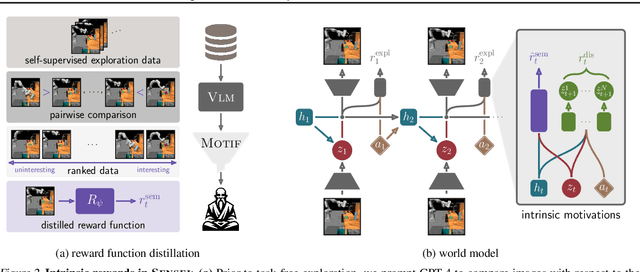
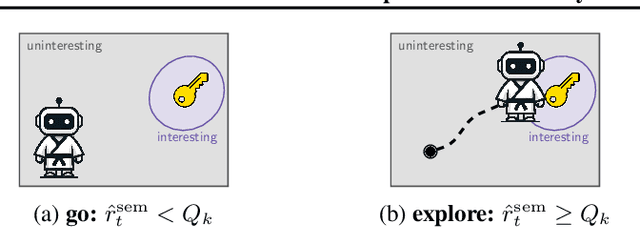
Abstract:Exploration is a cornerstone of reinforcement learning (RL). Intrinsic motivation attempts to decouple exploration from external, task-based rewards. However, established approaches to intrinsic motivation that follow general principles such as information gain, often only uncover low-level interactions. In contrast, children's play suggests that they engage in meaningful high-level behavior by imitating or interacting with their caregivers. Recent work has focused on using foundation models to inject these semantic biases into exploration. However, these methods often rely on unrealistic assumptions, such as language-embedded environments or access to high-level actions. We propose SEmaNtically Sensible ExploratIon (SENSEI), a framework to equip model-based RL agents with an intrinsic motivation for semantically meaningful behavior. SENSEI distills a reward signal of interestingness from Vision Language Model (VLM) annotations, enabling an agent to predict these rewards through a world model. Using model-based RL, SENSEI trains an exploration policy that jointly maximizes semantic rewards and uncertainty. We show that in both robotic and video game-like simulations SENSEI discovers a variety of meaningful behaviors from image observations and low-level actions. SENSEI provides a general tool for learning from foundation model feedback, a crucial research direction, as VLMs become more powerful.
The Role of Tactile Sensing for Learning Reach and Grasp
Feb 27, 2025Abstract:Stable and robust robotic grasping is essential for current and future robot applications. In recent works, the use of large datasets and supervised learning has enhanced speed and precision in antipodal grasping. However, these methods struggle with perception and calibration errors due to large planning horizons. To obtain more robust and reactive grasping motions, leveraging reinforcement learning combined with tactile sensing is a promising direction. Yet, there is no systematic evaluation of how the complexity of force-based tactile sensing affects the learning behavior for grasping tasks. This paper compares various tactile and environmental setups using two model-free reinforcement learning approaches for antipodal grasping. Our findings suggest that under imperfect visual perception, various tactile features improve learning outcomes, while complex tactile inputs complicate training.
Advancing Out-of-Distribution Detection via Local Neuroplasticity
Feb 20, 2025Abstract:In the domain of machine learning, the assumption that training and test data share the same distribution is often violated in real-world scenarios, requiring effective out-of-distribution (OOD) detection. This paper presents a novel OOD detection method that leverages the unique local neuroplasticity property of Kolmogorov-Arnold Networks (KANs). Unlike traditional multilayer perceptrons, KANs exhibit local plasticity, allowing them to preserve learned information while adapting to new tasks. Our method compares the activation patterns of a trained KAN against its untrained counterpart to detect OOD samples. We validate our approach on benchmarks from image and medical domains, demonstrating superior performance and robustness compared to state-of-the-art techniques. These results underscore the potential of KANs in enhancing the reliability of machine learning systems in diverse environments.
Dual-Force: Enhanced Offline Diversity Maximization under Imitation Constraints
Jan 08, 2025


Abstract:While many algorithms for diversity maximization under imitation constraints are online in nature, many applications require offline algorithms without environment interactions. Tackling this problem in the offline setting, however, presents significant challenges that require non-trivial, multi-stage optimization processes with non-stationary rewards. In this work, we present a novel offline algorithm that enhances diversity using an objective based on Van der Waals (VdW) force and successor features, and eliminates the need to learn a previously used skill discriminator. Moreover, by conditioning the value function and policy on a pre-trained Functional Reward Encoding (FRE), our method allows for better handling of non-stationary rewards and provides zero-shot recall of all skills encountered during training, significantly expanding the set of skills learned in prior work. Consequently, our algorithm benefits from receiving a consistently strong diversity signal (VdW), and enjoys more stable and efficient training. We demonstrate the effectiveness of our method in generating diverse skills for two robotic tasks in simulation: locomotion of a quadruped and local navigation with obstacle traversal.
Temporally Consistent Object-Centric Learning by Contrasting Slots
Dec 18, 2024



Abstract:Unsupervised object-centric learning from videos is a promising approach to extract structured representations from large, unlabeled collections of videos. To support downstream tasks like autonomous control, these representations must be both compositional and temporally consistent. Existing approaches based on recurrent processing often lack long-term stability across frames because their training objective does not enforce temporal consistency. In this work, we introduce a novel object-level temporal contrastive loss for video object-centric models that explicitly promotes temporal consistency. Our method significantly improves the temporal consistency of the learned object-centric representations, yielding more reliable video decompositions that facilitate challenging downstream tasks such as unsupervised object dynamics prediction. Furthermore, the inductive bias added by our loss strongly improves object discovery, leading to state-of-the-art results on both synthetic and real-world datasets, outperforming even weakly-supervised methods that leverage motion masks as additional cues.
Zero-Shot Offline Imitation Learning via Optimal Transport
Oct 11, 2024
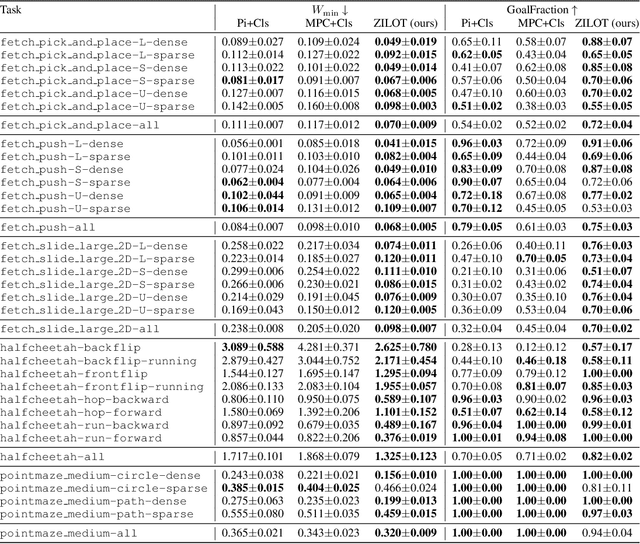

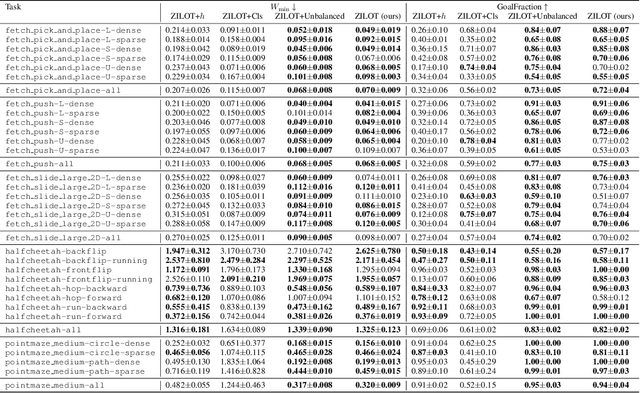
Abstract:Zero-shot imitation learning algorithms hold the promise of reproducing unseen behavior from as little as a single demonstration at test time. Existing practical approaches view the expert demonstration as a sequence of goals, enabling imitation with a high-level goal selector, and a low-level goal-conditioned policy. However, this framework can suffer from myopic behavior: the agent's immediate actions towards achieving individual goals may undermine long-term objectives. We introduce a novel method that mitigates this issue by directly optimizing the occupancy matching objective that is intrinsic to imitation learning. We propose to lift a goal-conditioned value function to a distance between occupancies, which are in turn approximated via a learned world model. The resulting method can learn from offline, suboptimal data, and is capable of non-myopic, zero-shot imitation, as we demonstrate in complex, continuous benchmarks.
Active Fine-Tuning of Generalist Policies
Oct 07, 2024

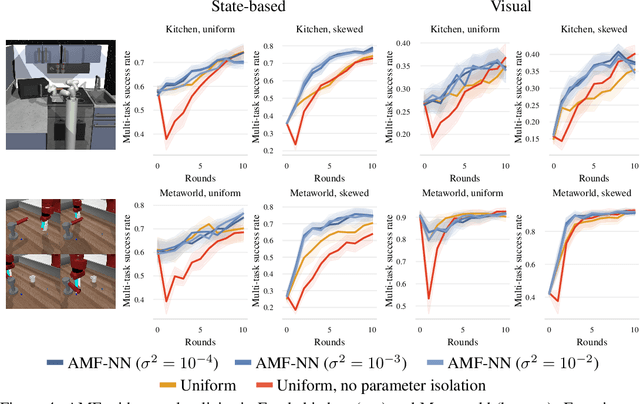
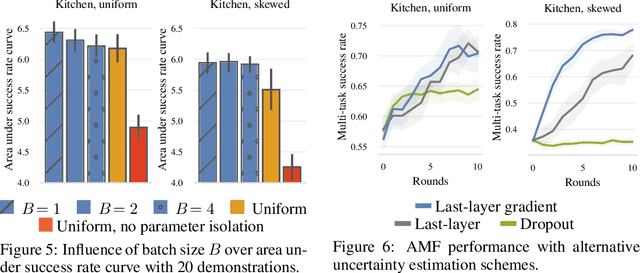
Abstract:Pre-trained generalist policies are rapidly gaining relevance in robot learning due to their promise of fast adaptation to novel, in-domain tasks. This adaptation often relies on collecting new demonstrations for a specific task of interest and applying imitation learning algorithms, such as behavioral cloning. However, as soon as several tasks need to be learned, we must decide which tasks should be demonstrated and how often? We study this multi-task problem and explore an interactive framework in which the agent adaptively selects the tasks to be demonstrated. We propose AMF (Active Multi-task Fine-tuning), an algorithm to maximize multi-task policy performance under a limited demonstration budget by collecting demonstrations yielding the largest information gain on the expert policy. We derive performance guarantees for AMF under regularity assumptions and demonstrate its empirical effectiveness to efficiently fine-tune neural policies in complex and high-dimensional environments.
 Add to Chrome
Add to Chrome Add to Firefox
Add to Firefox Add to Edge
Add to Edge